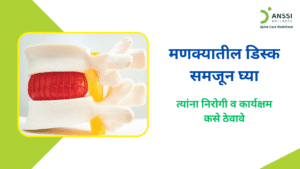In today’s digital age, millions of professionals spend most of their day sitting at desks, working on computers. While this work setup is convenient and productive, it comes with a hidden risk: spinal health issues, especially slipped discs.
Prolonged sitting, poor posture, and lack of movement are key contributors to spinal disc problems. Fortunately, with the right awareness and habits, you can protect your spine and prevent long-term damage.
What is a Slipped Disc?
A slipped disc, also known as a herniated or prolapsed disc, occurs when the soft, gel-like inner portion of a spinal disc pushes through a tear in the outer layer. This protruding material can press on nearby spinal nerves, leading to pain, numbness, tingling, or weakness, most often in the lower back, buttocks, legs, or neck.
Desk workers are particularly vulnerable to this condition because of the repetitive strain and static posture associated with long hours of sitting. Many times, people are unaware that their daily work habits are silently damaging their spine until symptoms start affecting their quality of life.
Why Desk Jobs Increase the Risk
Several elements of desk jobs can increase the likelihood of developing a slipped disc:
- Poor Ergonomics: Using a chair or desk that doesn’t support proper posture can lead to spinal misalignment. Without lumbar support, your lower back bears more strain.
- Prolonged Sitting: Staying seated for hours puts continuous pressure on spinal discs, reducing circulation and hydration, and speeding up disc degeneration.
- Slouching or Forward Leaning: Common during computer use, this posture compresses the spine, especially the lumbar region, increasing the risk of disc herniation.
- Lack of Core Engagement: A weak core fails to support the spine adequately, placing more load on spinal structures.
- Repetitive Movements: Twisting or bending frequently (even minor movements like turning to pick up the phone) without proper support can strain the discs over time.
The first step in prevention is to comprehend these risk factors.
Practical Tips to Prevent Slipped Discs
The good news is that preventing slipped discs doesn’t require major lifestyle changes; just mindful, consistent habits. Here are effective ways to protect your spine while working at a desk:
1. Set Up an Ergonomic Workstation
Get an ergonomic chair that provides lumbar support. Your knees should be at a 90-degree angle with your feet flat on the floor. Ensure your computer screen is at eye level to avoid neck strain. A sit-stand desk can also help by allowing you to alternate between sitting and standing.
2. Take Frequent Breaks
Avoid staying in one position for too long. Take a short break every 30 to 60 minutes to stand, walk, or stretch. Even 2-minute micro-breaks can make a difference in relieving spinal pressure and improving circulation.
3. Practise Good Posture
Sit with your back straight and shoulders relaxed. Avoid slumping or leaning forward. Keep your elbows close to your body, and use a keyboard and mouse that don’t require awkward wrist movements. You can also place a small cushion or rolled-up towel behind your lower back for additional support.
4. Strengthen Your Core Muscles
Your core, including your abdominal, back, and pelvic muscles, plays a vital role in stabilising your spine. Incorporate core-strengthening exercises into your routine, such as planks, bridges, or Pilates. A strong core reduces the load on your spinal discs and improves overall posture.
5. Stay Hydrated
Spinal discs are composed largely of water, which they need to maintain height and flexibility. Dehydration can accelerate disc degeneration. Drinking sufficient water throughout the day keeps your discs nourished and resilient.
6. Maintain a Healthy Weight
Excess body weight, especially around the midsection, adds pressure to the lower back and increases the risk of disc problems. A balanced diet and regular physical activity can help manage weight and support spinal health.
7. Use Proper Lifting Techniques
Even if your job isn’t physically demanding, lifting items incorrectly can harm your spine. Always lift with your legs, not your back, and avoid twisting your torso while holding heavy objects.
Don’t Ignore Worsening Symptoms
Despite best efforts, some people may still experience signs of a slipped disc.
These include:
- Persistent lower back or neck pain
- Pain that radiates down the legs or arms
- Numbness or tingling in the limbs
- Weakness in specific muscles
If you experience these symptoms, it’s important not to ignore them. Early diagnosis and treatment can prevent further damage. Non-surgical treatments like spinal decompression, physical therapy, and postural correction exercises can help relieve pressure on the spinal discs and promote healing without surgery or medication.
About ANSSI:
ANSSI Wellness focuses on improving the quality of life for patients suffering from spinal issues, aiming to provide relief where other conventional treatments have failed. Through advanced non-surgical spinal decompression treatment, ANSSI is committed to helping patients avoid surgery and recover in a safe, effective, and compassionate environment.
Connect with ANSSI Wellness on LinkedIn, Instagram, and Facebook for expert guidance.



